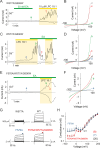Functional determinants of lysophospholipid- and voltage-dependent regulation of TRPC5 channel
- PMID: 39210039
- PMCID: PMC11362415
- DOI: 10.1007/s00018-024-05417-7
Functional determinants of lysophospholipid- and voltage-dependent regulation of TRPC5 channel
Abstract
Lysophosphatidylcholine (LPC) is a bioactive lipid present at high concentrations in inflamed and injured tissues where it contributes to the initiation and maintenance of pain. One of its important molecular effectors is the transient receptor potential canonical 5 (TRPC5), but the explicit mechanism of the activation is unknown. Using electrophysiology, mutagenesis and molecular dynamics simulations, we show that LPC-induced activation of TRPC5 is modulated by xanthine ligands and depolarizing voltage, and involves conserved residues within the lateral fenestration of the pore domain. Replacement of W577 with alanine (W577A) rendered the channel insensitive to strong depolarizing voltage, but LPC still activated this mutant at highly depolarizing potentials. Substitution of G606 located directly opposite position 577 with tryptophan rescued the sensitivity of W577A to depolarization. Molecular simulations showed that depolarization widens the lower gate of the channel and this conformational change is prevented by the W577A mutation or removal of resident lipids. We propose a gating scheme in which depolarizing voltage and lipid-pore helix interactions act together to promote TRPC5 channel opening.
Keywords: Lysophosphatidylcholine; Pain; TRP channels; TRPC channels; Voltage-dependent gating.
© 2024. The Author(s).
Conflict of interest statement
The authors declare that they have no conflict of interest.
Figures





Similar articles
-
Cryo-EM structure of TRPC5 at 2.8-Å resolution reveals unique and conserved structural elements essential for channel function.Sci Adv. 2019 Jul 24;5(7):eaaw7935. doi: 10.1126/sciadv.aaw7935. eCollection 2019 Jul. Sci Adv. 2019. PMID: 31355338 Free PMC article.
-
Molecular Determinants of the Sensitivity to Gq/11-Phospholipase C-dependent Gating, Gd3+ Potentiation, and Ca2+ Permeability in the Transient Receptor Potential Canonical Type 5 (TRPC5) Channel.J Biol Chem. 2017 Jan 20;292(3):898-911. doi: 10.1074/jbc.M116.755470. Epub 2016 Dec 5. J Biol Chem. 2017. PMID: 27920205 Free PMC article.
-
TRPC5 channels undergo changes in gating properties during the activation-deactivation cycle.J Cell Physiol. 2008 Jul;216(1):162-71. doi: 10.1002/jcp.21388. J Cell Physiol. 2008. PMID: 18247362 Free PMC article.
-
Emerging issues of connexin channels: biophysics fills the gap.Q Rev Biophys. 2001 Aug;34(3):325-472. doi: 10.1017/s0033583501003705. Q Rev Biophys. 2001. PMID: 11838236 Review.
-
TRPC5.Handb Exp Pharmacol. 2014;222:129-56. doi: 10.1007/978-3-642-54215-2_6. Handb Exp Pharmacol. 2014. PMID: 24756705 Review.
Cited by
-
Thermosensing ability of TRPC5: current knowledge and unsettled questions.J Physiol Sci. 2024 Oct 3;74(1):50. doi: 10.1186/s12576-024-00942-3. J Physiol Sci. 2024. PMID: 39363236 Free PMC article. Review.
References
-
- Friston DA, Cuddihy J, Souza Luiz J, Truong AH, Ho L, Basra M, Santha P, Oszlacs O, de Sousa VJ, Marczylo T et al (2023) Elevated 18:0 lysophosphatidylcholine contributes to the development of pain in tissue injury. Pain 164:e103–e115. 10.1097/j.pain.0000000000002709 10.1097/j.pain.0000000000002709 - DOI - PMC - PubMed
MeSH terms
Substances
Grants and funding
LinkOut - more resources
Full Text Sources

